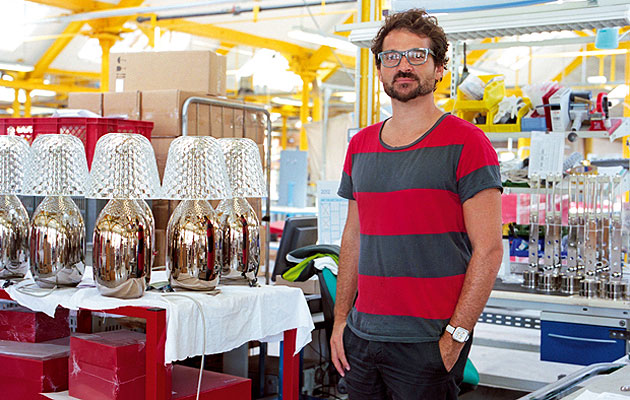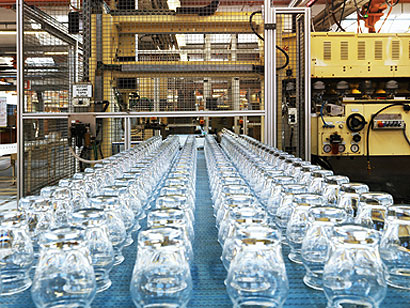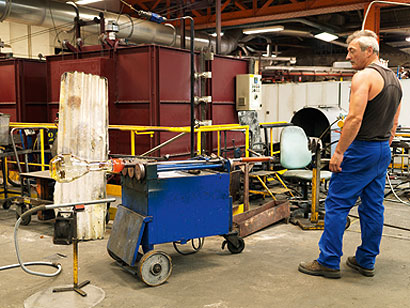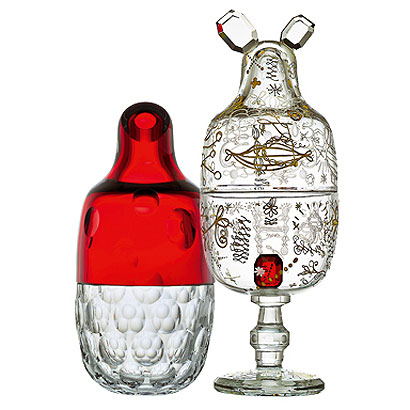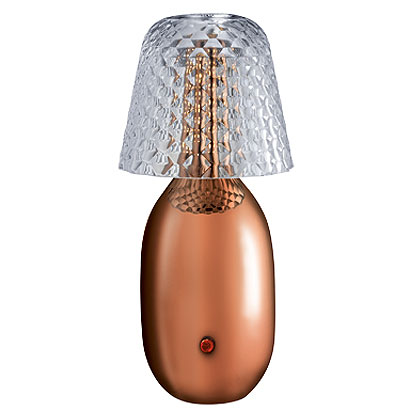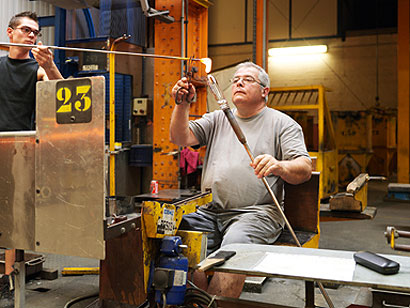|
|
||
|
The setting, three hours east of Paris, is idyllic. A handsome chateau stands at one end of a large green. Through an avenue of chestnut trees is the Baccarat crystal factory, a church-like building with six large, arched windows, emblazoned with a coat of arms depicting a clenched fist hovering over a crystal glass. The rectangle of grass is lined on both sides by workmen’s cottages with faded pink and green shutters; they accommodate 60 families and were originally lived in exclusively by glassblowers who would rush to work when the bell on top of the factory rang out, warning that the crystal in the furnaces had reached the right temperature and needed to be worked upon. A bird’s-eye view image of the village in 1900, when the factory was busy supplying Tsar Nicholas II and the Russian market, reveals that it was wholly given over to glassmaking. The constantly stoked furnaces were fed by wood delivered by river from nearby forests. Six tall chimneys belched perpetual smoke. We visit the Baccarat factory at midnight, walking there from the chateau by the light of a crescent moon. Inside everything is ablaze; the startling noise of the furnaces resembles an aircraft about to take off. Because these burn around the clock, 20 employees work the nightshift, toiling in the sweltering heat from 8pm to 4am. Apart from one woman, all the glassblowers are male, and wear earplugs, vests and sport a gallery of tattoos. They sweat in the huge vaulted space as they carry burning pokers of molten crystal between the furnaces and the workstations, where the silicone is blown into specially constructed moulds. An archive of 45,000 of these shapes, used since 1765 by one of the oldest manufacturers of glass, are stacked around the factory space where they rust on shelves like discarded carburetors. Each label tells a piece of the company’s history: Services Vienne, Services Armagnac, Services Casino Austerlitz, Services Diablo José …
Baccarat has supplemented these classic designs with new products by Philippe Starck, Arik Levy, Marcel Wanders, Patricia Urquiola and Jaime Hayón. Many of these designers have also worked with Venetian glassmasters, who have a much more gestural technique, stretching and pulling the glass to give it shape (Icon 095). In contrast, the French technique uses moulds and emphasises structure, symmetry and geometry. Much of the magic happens in post-production, when the crystal is engraved and cut. “In Italy you see results immediately, they are playing with glass as if it were a ballerina,” Hayón explains of the different techniques when I meet him at the Baccarat factory. “Here you have to imagine it, you have to find the elegance, you have to cut the glass like a diamond to allow light in like a lens – it’s like a workshop in which they are finding the beauty of linearity, getting reflections going and seeing what the light does. Elaboration makes it alive.” The night I visit, six men are working on Patricia Urquiola’s Variations series, rolling huge globs of glass into wooden shaping blocks, stretching them in stocks to create a neck, and blowing them with pneumatic pumps in heated moulds (only the smaller pieces are blown by mouth, to preserve the workers’ lungs). It’s a well-rehearsed ballet in which the glassblowers work in sync to create 50 vases a night. A visit to the Baccarat archive, which occupies an adjoining building, shows how little the scene has changed since the invention of photography. All the instruments are essentially the same, apart from a few automated additions – foot pedals, for example, have replaced the young boys who were once employed in the pits into which the glass is blown, where they stood half-submerged and opened and closed the moulds. The largest furnace has 21 openings, each of which holds 100kg of molten glass that is heated to a temperature of 1,450ºC. Inside are pots of different coloured glass: orange, blue, cobalt, amber, emerald, green, ruby and amethyst. Strips of leftover glass, like strands of technicolour spaghetti, mark the floor in front of the furnaces, which are covered in sheets of corrugated metal when they are not in use to protect against the heat.
The workmen perform their jobs in silence – it’s too noisy to speak – and never stop turning the hot crystal, skillfully revolving them on blowpipes like Chinese acrobats might use poles to spin plates. When they’ve finished blowing and working the crystal, they hang the used pipes on a stand like those that support pool cues, from where the remaining bits of glass shatter noisily into the bins below. The finished pieces are placed on a conveyer belt that moves at imperceptible speed through a special furnace that gradually reduces the heat of the glass so that it does not shatter as it cools. Out of this comes sculptural blocks of crystal – neatly arranged armies of chandelier arms, tumblers, champagne flutes, vases and decanters – that will be refined the following day. Unlike the hot workshops, which are a male preserve, with only three women for 300 male workers (an impression reinforced by the pornography that lines the gym lockers and coffee cupboard in that space), the cold workshops are a largely female domain. Here workers choose, polish, cut and engrave the crystal. Quality control is strict. Of the Urquiola vases blown the previous night, about half are rejected. One woman is inspecting the pieces for imperfections under a harsh light. Like the company grammarian, she circles each tiny flaw in red pen. “A poubelle,” she says, discarding one piece because of a comma-sized bubble hardly noticeable to the naked eye. Another is testing the thickness with an electronic device that resembles a stethoscope. Vases that are too thin to be properly cut are also put on the reject pile, to be melted down and recycled.
The hand-finished elaborations that follow are time-consuming; one ruby goblet, with a lengthy stem, takes 26 hours to finish; the door of a liquor cabinet takes 50 hours to engrave with a rococo still life. (“The etching blows your mind,” Hayón tells me, “the elaboration is completely nuts – it’s extremely complicated, precise drawing done with a wheel that spins as fast as a motorcycle.”) Another worker is etching finished glass pieces with the company logo, blowing fine sand on to the crystal through a stencil. She does this 700 times each shift. “I’m dreaming of the beach every day,” she says. Hayón, who began his collaboration with Baccarat in 2008, is at the factory working on a chandelier, which will launch in Milan next year. It uses the shades from his Candy Lights (which weigh between one and five kilos), as bowls of light that are mounted on a metal frame like upturned beehives. Several people crowd around, discussing various combinations of materials. Most of Baccarat’s chandeliers were designed 150 to 200 years ago, Hayón says, pointing to Starck’s black chandelier and explaining that all the designer did was change the colour. Hayón wants to “introduce a new world of modernity to the chandelier, to engineer a skeleton that makes it look different, to have the splendour of crystal but in this century”. He brandishes some camouflage cording, with which he hopes to make an aesthetic of the electrical wiring. “The honeycomb cut is iconic for Baccarat,” Hayón tells me, running a finger over one of his crystal shades, “but it’s normally used vertically – I’ve used it horizontally.” Hayón immersed himself in the company’s archive, and their long tradition, before coming up with his own designs, which he presented in drawings that imitated those that the glass masters were used to working from. “I was really respectful,” he says, “stepping little by little, trying to really understand what they do. I had worked a lot in ceramics, but crystal was like a new language. It’s like another religion – like going to a new country and experiencing culture shock. When I came here I was excited to understand it in the best way I could; analysing things and then proposing innovations.”
In his original Candy series, a limited edition of brightly coloured jars, the designer was interested in learning to control the light, trapping it with facets so that it would ricochet around and illuminate the glass: “For me a cut is like a constellation,” he says. Hayón felt it was imperative to visit the factory. “It is a field that has an absolute language that you can only learn by doing – there’s no other way,” he explains. “What I’ve realised in the last six years of working with crystal is that you can’t send someone else from your office – you have to go yourself. You have to commit – I can tell you, if you’re not truly into it you won’t achieve any beauty.” He spent hours discussing the limitations and possibilities of the medium with expert craftsmen who have been cutting glass for almost 40 years, so that he could invert their classical language, introducing new accents. “I break a lot of their boundaries. For example, they always work with geometry, and I’ve done pieces with irregular crescendo cuts as well as mixing patterns, combining an 1800s tradition with a circle, which is a 1970s style. I’ve juxtaposed the crystal with ceramics, which they were really scared about because the crystal on top is so heavy, and you don’t want it to crack. They are committed to quality. Any little bubble or error – in the trash!” It is testimony to the company that it encourages such subversions. The design of its popular Harcourt glass, a goblet with a big, heavy cut that creates a splendid effect, is now 170 years old. A small chapel that sits at one end of the row of workmen’s cottages has been converted into a gallery, where there is an exhibition devoted to various adaptations of its sturdy form. Starck has finished it in his trademark black crystal; Xin Wang has inverted the glass and created a chess set by adapting its base; Inga Sempé has done the same, but to fashion candlesticks; Yu Tian has fused two glasses to create an hour glass; Elsa Lambinet has joined and stretched a set to create a long bowl; Ecal Guillaume Noiseux has added a metal lemon squeezer and other culinary devices to create a cocktail kit. Hayón, with a nod to his Zoo series – jars with comic animal heads – has added Mickey Mouse ears. “I wanted to play with the tradition”, he explains, summarising his method. “I want to explore the material and challenge it. And at the same time, though respecting that heritage, I want to give a little humour to it.”
|
Image Felix Friedmann
Words Christopher Turner |
|
|
||

